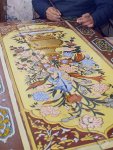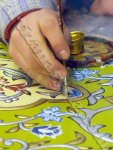Marquetry ( Al-Ajami )
Marquetry is an old Damascene handmade craft that is inherited and excelled by artists through the ages. They have contributed in the decoration of houses and palaces the original Eastern characteristics. What matters most in this art is the ( nabbata ) substance which makes the decorative embossed pattern that has been a secret of how to be made but the true secret is the creative craftsman himself.
It has been called ( al-ajami ) because of the blending of motifs that is been clear in the Persian, Turkish, Moroccan and Arabic art and as it is stated in the old eras of Greek, Roman … etc.
- Marquetry Making Process:
It is made using polished-sides veneer woods in different sizes based on the desired shape and pattern, marquetarians had already varnished this wood with a reservation substance ( darsh ) to reserve its heat and moistness and make it easy to work on. Then they draw the desired geometric or  plant pattern using a special fine abrasive paper ( glick paper ) that allows to make accurate forms and drawings. Then they prepare a special putty made of zinc, ceruse and glue using a brush on the veneer wood and a cutter tool to have accurate embossed sides that match between the paper and putty with the same thickness in order not to distort the drawing by mistake.
plant pattern using a special fine abrasive paper ( glick paper ) that allows to make accurate forms and drawings. Then they prepare a special putty made of zinc, ceruse and glue using a brush on the veneer wood and a cutter tool to have accurate embossed sides that match between the paper and putty with the same thickness in order not to distort the drawing by mistake.
Then we leave the pattern for a day or two so that the putty gets dry and ready to absorb the colors which will be brushed exactly on the plants stems and geometric sides using special brushes with different sizes to make homogenous colors and avoid overlapping. After that, we have the most important optical elements which are the silver and golden colors which mostly stress the delicate spots of the designed pattern such as the leaves, sides and drawing centers while we leave the inside spaces to be filled with other colors like yellow, pink, green and others.
Having the painting completed, the marquetry panels are installed as ceilings or walls and they use it often to decorate ceremonies, reception halls and guests rooms so that it looks Eastern. It can be also used to decorate folk meeting rooms, doors, offices, chairs and windows to focus on its important feature of maintaining colors quality and brightness for hundreds of years as good as it is reserved well as we have a good evidence such as the Throne room in Aleppo and as in Damascus Museum and the Museum of Hama.
- Marquetry Ornamentation Types:
Floral (plants) Ornamentation: Artist’s paintings are inspired by nature and he tried to abstract nature of its reality by his ability to copy forms and abstract things into forms and decorative patterns
Geometric Ornamentation: It gives a sense of stability and consistency and that the nature of the geometric ornamentation lives by tranquility. However, these lines are active and dynamic that it gives a sense of movement to stimulate the geometric directions among the Square, circle and triangle.
- Marquetry Fame:
Chami marquetry ( al-ajami ) has an internation fame noting that “Metropolitan”; the world’s most famous museums , has a hall called ( Damascus ) which is decorated with al ajami. Besides, Library Hall of NY University is also decorated with this Chami ornamentation.
The most important creation of Ajamai which amazes visitors and tourists are reflected in the meeting room of the Syrian Parliament in Damascus which is a unique art masterpiece. Chami old Halls also are witnesses of this art innovation such as House of Culture and Nizam House and other old house in Damascus. In addition to the Conference Hall in the Province of Damascus and the Throne Room in Aleppo.
